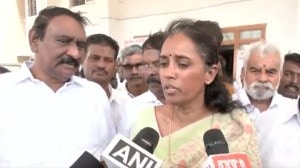HOW GREEN WAS MY VALLEY
India are breaking tradition by hosting a Davis Cup tie on hardcourt,out of compulsion rather than choice. Is this the end of Indias grasscourt romance,asks our correspondent
India are breaking tradition by hosting a Davis Cup tie on hardcourt,out of compulsion rather than choice. Is this the end of Indias grasscourt romance,asks our correspondent
Just like Albert Einsteins e=mc2,the Indian Davis Cup teams,too,had devised a fairly successful formula over the years: Playing at home = Grass. For them,the surface was definitely not for the cows as once famously remarked by Ivan Lendl and with the serve-and-volley mastery of players such as the Krishnans,the Amritrajs,Jaidip Mukerjea and Premjit Lall making the good old chip-and-charge routine formidable,visiting teams knew they were in for a keen contest.
There have been a few exceptions to the grass-at-home rule,and while the last one dates back to 1979 an Eastern Zone semi-final against Australia at the Madras Gymkhana clay courts which India lost 3-2 the next such experiment is just a couple of months away.
Hardcourts have been deemed the surface of choice for Indias third round Asia/Oceania Group I tie against Australia in May,but while 30 years ago the choice was made keeping in mind that grass fell in the Aussies comfort zone,this time around,Indias highest-ranked player is the huge factor. Somdev Devvarman had a patchy Davis Cup debut on grass last February,but his feats on synthetic surfaces since then have ensured that his preference is the only priority for India.
There is no question about it,grass will not be the surface for this tie, says Indias non-playing captain SP Mishra. The main reason is Somdev. He loses his strength on grass,his game is more suited to other surfaces.
The decision,considering Indias record,is being seen as sensational. Three-time runners-up in 1966,1974 and 1987,some of Indias most memorable wins have come on grass. Be it an over-the-hill Vijay Amritraj recreating the magic of yore against Argentina in New Delhi,and then the reigning champions Australia in Sydney in the run of 87,or Leander Paes playing his heart out against the mercurial Goran Ivanisevic as India saw off formidable Croatia 3-2 in the World Group qualifiers.
But in this story of sheer desperation that Indian tennis has become their last major win came against Chile back in 1997 the switch is hardly that monumental considering the embarrassment of poverty as far as singles options are concerned.
If the grasscourt formula seemed foolproof in the past,it had a lot to do with the class of the Krishnans and the Amritrajs on this surface. In recent times,however,even beating lesser-ranked teams at home on grass was becoming an uphill climb. On the grasscourts of Mumbai in 2006,Paes,now a doubles specialist,was made to play the fifth and deciding rubber of the Asia/Oceania 1st-round playoff against Pakistans Aqeel Khan. He managed to pull it off in five sets,but not without raising questions about the state Indian tennis was in. And the situation has barely improved in the last four years.
Different buzz
Despite their suspect fitness,singles players Rohan Bopanna and Prakash Amritraj racked up some small wins along the way,but neither of them them inspire a great deal of confidence about the future. Now,the buzz around Devvarman is different,and his singles performance is surely the key to Indias chances in the Davis Cup. We have quite a thin team,Somdev doesnt have much support, says former Davis Cup captain Naresh Kumar. I was quite disappointed with the way Rohan played against Chinese Taipei. He has the weapons,but doesnt know how to use them. We really dont have many options,but Somdev has stemmed Indian tenniss slide somewhat. He needs to put on more muscle,and continue training with a top-class player like Andy Roddick,even if it means missing out on a few tournaments. Being around players like Roddick,seeing how they train,their work ethic,is extremely important.
Kumar adds: In my opinion,there should be no second thoughts the tie should be played on the hardcourts in Chennai where he (Devvarman) did so well in January during the ATP event. Hes the only trump card we have. Bopanna is getting older,Prakash is out of the picture,and Yuki (Bhambri) will take a few more years. It is a departure from tradition,but times have changed. Back in our days,grasscourt play was our strength,we took refuge in serve and volley because of our lack of groundstrokes. But since our best player now doesnt play that kind of tennis,we obviously need to change.
Gone are the days
Former Davis Cup player Akhtar Ali agrees that the question of grass doesnt arise anymore. We need to ask Somdev what kind of hardcourt he prefers. The surface will obviously be selected by the player who can win us the singles,and in this case,its him. Krishnan,Amritraj,Lall and even Paes had some big wins on grass over the years,but that time has gone. Where are the players now? There are no tournaments on grass these days,even the grasscourt nationals havent been taking place. Right now,Somdev is the best weve got,and we must learn to be flexible as far as the surface is concerned.
Ramesh Krishnan,the architect of not only many a grasscourt victory at home, but also wins on clay and hardcourts overseas,says Devvarmans promise is the best news for Indian tennis in over a decade. A few months ago,I didnt really think Somdev would come into his own so quickly,but Im glad that things are now looking up. We have to take into consideration the younger players sooner or later,and the time is now. But we need more singles players, he says.
His father Ramanathan,the original Indian globe-trotter,had captained India in that hardcourt encounter of 1979. Till this year,things were very gloomy. Our players were getting older,and there really didnt seem to be anybody who would assume the responsibility of taking on a vital position in the team in singles. Australia will be tough,even for him (Devvarman),but it depends on who they bring in their team, says Ramanathan.
So,while the debate over grass is over,surely the bigger issue now is the perennial problem of Indian tennis being unable to spring up good enough players for the Davis Cup team. And while Devvarman,according to those who have been part of the countrys glory days,has made the situation slightly better,he isnt exactly a top-50 draw as yet. Its this dearth of talent that has turned a tradition on its head,and the era of grasscourts for Davis Cup ties in India may well be over after this encounter.
Mahesh Bhupathi says he was expecting Somdev to pull off the big win against world No 59 Yen-hsun Lu in Chinese Taipei last week,but even he was surprised with the ease with which he wrapped up the decisive rubber for India. He,however,isnt certain that the departure from grass will be permanent.
Im not saying that Somdev cant play on grass,but we need to look at the Aussies. Hewitts been a Wimbledon champion,so his command of the surface is superb. Somdev is much more comfortable on hard courts,so it makes sense for us to play on hardcourt, says Bhupathi.
Once upon a time,the grass was always greener on this side. But now,grass or no grass,Indias tennis ambitions have been ground into the dust repeatedly. The last time they made the Davis Cup World Group was back in 1998,and the struggle to stay afloat in the zonal draws continues.
As things stand,its hard to say when or if grass will make a comeback. But its even harder to pinpoint when India will be in Davis Cups elite bracket again.






- 01
- 02
- 03
- 04
- 05

























